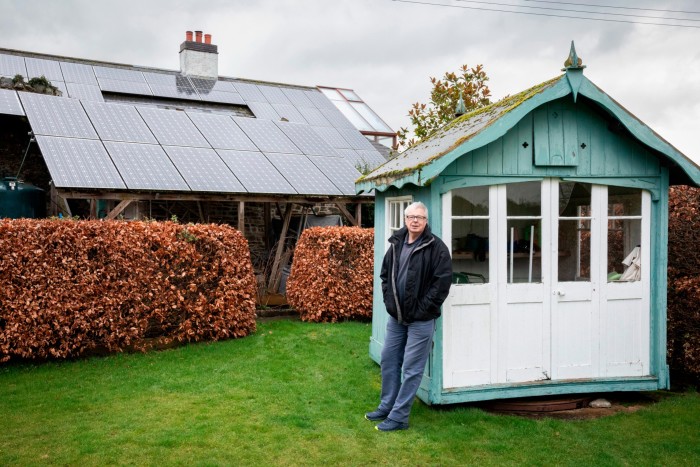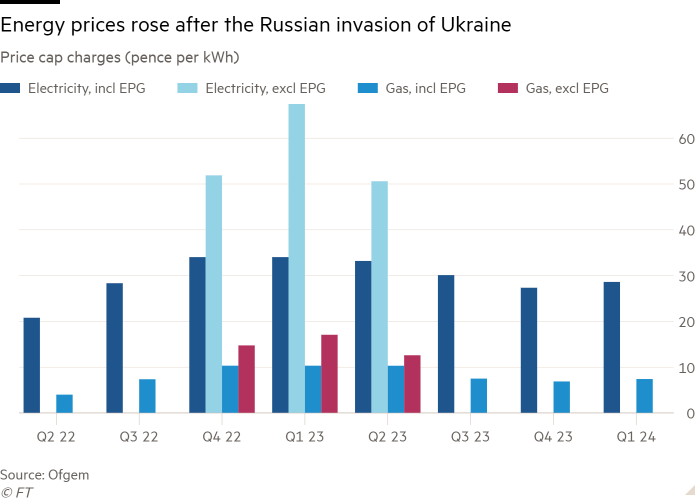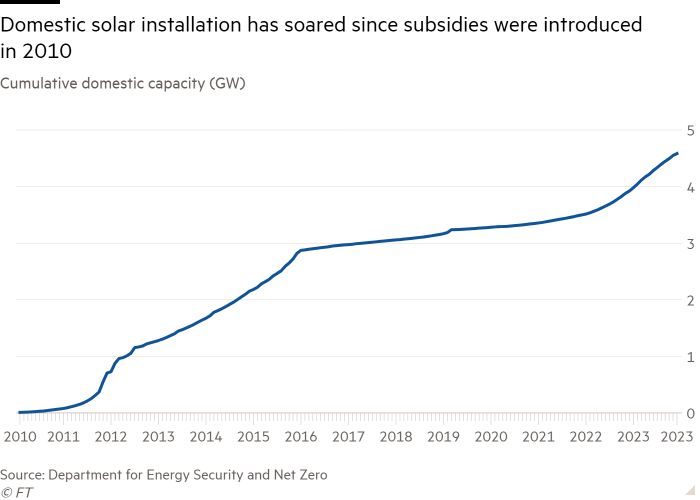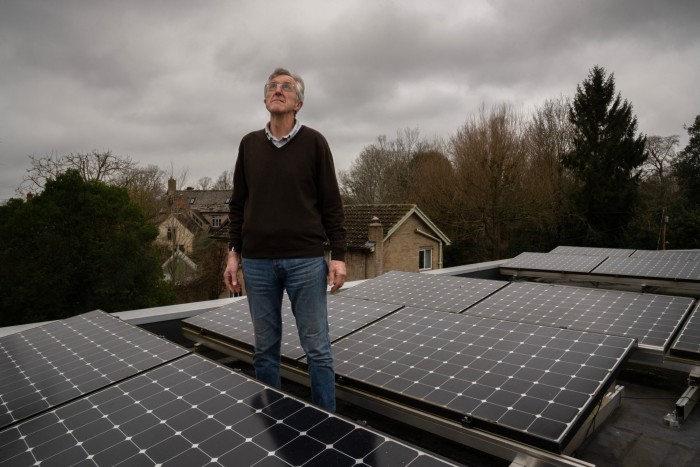In 2010, Dr Adrian Penney, a GP in Bishop’s Castle, Shropshire, decided to find a new, creative and green use for his children’s premium bond money.
Having been “dead keen on insulation for years”, the 68-year-old installed 2.4 kilowatt peak (kWp) worth of solar photovoltaics — better known as solar panels — as a way to increase the energy efficiency of his properties and set a good example to his community.
He took the savings he made on his bills and ploughed that amount back into his children’s premium bonds. But the green aspect of the installation was just as important to him. “As a GP, being seen to be doing it could give others confidence that it’s a reasonable thing to do.”
Like Penney, many people who look into installing solar panels are motivated by environmental concerns. But a surge in energy bills following the start of the war in Ukraine led more households to consider them — along with other energy-saving measures such as insulation and double glazing.
According to MCS, a renewable energy certification scheme, 183,000 solar installations were carried out in 2023, up one-third from the previous year. Panels have become steadily more efficient, along with the large batteries often used to store and release energy from the system.
However, adorning your home with solar panels is not a financial dead cert. The results depend on your energy consumption, your home’s location, timeframe, the availability of reliable installers and politicians sticking to their green commitments. FT Money looks at the main factors that will determine whether an investment in solar works.

Financing basics
A typical 3.5kWp system costs £7,000 — which includes the hardware and installation — and takes up around 20 sq metres, according to the Energy Saving Trust (EST), an energy consultancy. These systems should last 25 years and sometimes require cleaning and maintenance at an extra cost.
Key factors that determine whether solar would be right for a household are its energy consumption, as well as its location, which determines the total exposure of panels to peak sun hours.
In the past, the direction a roof faced was an important consideration. With today’s technology, it matters less, as panels have become steadily more efficient at turning sunlight into energy in the past decade. Residential solar panels have an average efficiency rate of around 15 to 21 per cent. In 2010, the highest achieved efficiency was 15.89 per cent.
“I would say anyone with some kind of unshaded roof space should at least explore it,” said the EST’s knowledge manager Joanna O’Loan. “I also wouldn’t rule out anyone with an east- or west-facing roof, as we might have done 10 years ago.”

One of the advantages of solar panels is that homeowners can reduce their costs by feeding energy back to the national grid. From 2010 to 2019, the government offered generous subsidies in the form of a feed-in tariff (FiT), which initially offered 41.3p per kWh generated.
Under the 2010 FiT subsidy, power generated from solar in the UK leapt from 0.04 terawatt hours (TWh) to 12.42 TWh in 2019, according to Our World In Data, a data research group. When FiT ended, growth in the sector slowed. However, it has since picked up again, with 13.92 TWh generated in 2022.
When the FiT tariff scheme was rolled back, it was replaced by the so-called “smart export guarantee” (SEG), under which electricity companies offer different tariffs and prices for domestic energy and customers can shop around. This can be fixed or variable depending on market demand, although prices will never fall below zero.
According to the EST’s estimates, on an SEG tariff of 5.5p/kWh and a standard tariff of 30p/kWh, a Londoner who works from home could save £565 a year. One with an office job that brings them home at 6pm could save £350. This is because panel owners are unlikely ever to make more money exporting to the grid under current SEG rates than they would save by using solar-generated energy.
Scammers out for a quick buck
“Cowboy” solar installation companies have been accused of making false promises, overcharging, cutting corners and disappearing without a trace when customers seek redress.
Chris Hewett, chief executive of trade body Solar Energy UK, says these companies entered the market around 2010, when the government was offering generous subsidies in the form of a feed-in tariff (FiT). This led to a proliferation of companies seeking to make a “quick buck”.
In 2021, Bruce Chisholm, a commercial property finance consultant, decided on a system at 7.9kWp — a measure of output. Although he lives near Perth, a Canary Wharf-based company offered to complete his installation as a loss leader for £11,500, so it could expand its business into Scotland. However, the company went quiet for months. Eventually it offered to sell him the equipment for £12,500 without installing it.
“We went backwards and forwards and eventually I just threw in the towel and said, ‘Look, give me my deposit back and we’ll call it quits’,” he says.
The next company he found completed his £16,500 installation after a six-month delay, but when he chased up the warranty documentation he discovered the company had gone bust and was being investigated by trading standards officials.
He then had to pay an additional £900 to have his panels certified, and fix incorrectly installed batteries and wires.
“There appear to be many ‘cowboys’ out there and I shall never achieve a return on my £17,500 outlay based on the first year figures unless power prices increase even more dramatically,” he says.
“It’s an area that people don’t know a huge amount about, so it’s really open for scams,” says Social Market Foundation researcher Niamh O’Regan, pointing to the number of national and local government schemes adding to homeowners’ confusion.
Homeowners are advised to check their contractor is MCS-certified.
However, homeowners with solar batteries and variable tariffs can target times when export prices are higher. These batteries are an added cost at the outset: based on the capacity needed, they can vary from £2,500 to £8,500.
“The main factor is what your electricity consumption is. The more of that power you can generate yourself the more advantageous [solar] becomes,” said Chris Hewett, chief executive of trade body Solar Energy UK. “And the price of residential batteries has really tumbled over the past five years — our members say at least 70 per cent of new installations include a battery, which gives people more control over their power use.”
The time taken for a solar installation to pay for itself has also dropped. According to Carbon Brief, a climate analysis and data provider, the payback period for a 3kWp system fell from 16 years in October 2020 to 10 years in January 2024.
Domestic electricity bills are capped by the UK regulator Ofgem, but a rise in the cap is another reason for homeowners to consider solar. In the wake of Russia’s invasion of Ukraine in March 2022, which led to a surge in oil and gas prices, the cap increased by 54 per cent to £1,971 a year. Average annual energy bills rose by 5 per cent on 1 January 2024 for households on standard price-capped tariffs to £1,928 a year.
Scott McKelvie, from Chichester, installed 8kWp worth of panels and a 10kWh battery in late 2022, after working as an environmental consultant for various oil companies. He paid £14,000 for his installation, and having saved £3,000 in 2023 expects the payback time to be under five years.
“It’s been a pretty big success for us. Solar provided all of our hot water through the summer and the battery makes a huge difference as you’re not always generating power when you need it,” he said. “At 4pm the cost of electricity is 30p, but at 7.30pm it goes down to 14p. I can run off the battery when it’s expensive, then it’s half the price a few hours later. That makes quite a difference.”
In 2023 he managed to generate more than 6MWh and export £250 worth, which he considers “poor value”. But to soak up his excess energy, he purchased an electric vehicle in September.
“Being newly retired I have too much time on my hands, so I look at the forward price and say ‘oh, we should charge the car tomorrow’,” he says.
However, while solar panels might be advantageous for homeowners with sufficient roof or land space, high energy consumption, bountiful sunlight and a good SEG deal, others can lock in savings more easily by opting for insulation or draught proofing.
“In some instances [panels] make a lot of sense,” says Capital Economics’s David Oxley. “But there are other things like insulation which are lower cost and you can do yourself a lot of the time.”

Politics of solar
Would-be solar installers have another factor to grapple with: politicians’ enthusiasm for green policies and incentives have waxed and waned in recent years.
Government schemes include Solar Together, an initiative that invites homeowners to join forces when bidding among suppliers for solar installation, thereby reducing their costs. Other schemes such as the Energy Company Obligation 4 and the Home Upgrade Scheme allow low-income households to get free or subsidised solar panels.
The government’s Green Deal loan scheme, which allows homeowners to spread the cost of buying solar over 10 to 25 years, has been offered through private providers since 2017. Buyers can also benefit from zero per cent VAT on panel purchases.
But the prospect of new or expanded initiatives is looking shakier after the government U-turned on a number of green targets. Labour also this week dropped its £28bn annual target for green investment amid tight public finances.
“The fiscal arithmetic has become a lot more challenging, which fundamentally will constrain the green transition,” says Oxley. “I think the government’s basically stepped back from providing huge amounts of financial incentives for solar.”
But there are several factors driving growth in the solar sector. The cost and efficiency of the technology has improved significantly, says Sugandha Srivastav, a lecturer in environmental economics at Oxford university, while some types of ground-mounted panels are now able to move in the direction of the sun.

“The solar sector is very innovative and fast-moving,” she says. “[If you’re a potential buyer] you need to update your data points every three months to keep track of the new innovations and the new cost structures.”
Challenges to the wider adoption of solar take several forms. Councils may refuse permission, particularly for listed buildings or on land adjoining the property. A broader point is the role of China in the supply of panels. Europe and the UK are heavily reliant on China for imports, with 66GW worth of panels imported to Europe in the first half of 2023, up from 44GW year on year.
If this supply is curtailed, costs are likely to rise. After the BBC revealed that panels used by the British Army were linked to forced labour in Xinjiang, UK Prime Minister Rishi Sunak faced calls for a ban on solar companies with links to Uyghur Muslim exploitation.
“A lot of the time governments will say we’re making panels domestically, but all they’re doing is assembling the parts,” says Brian O’Callaghan, an energy and environment consultant. “Upstream supply chains are really important to be cognisant of.”
While the solar technology has advanced quickly, whether or not to install panels will still depend on your physical set-up and what you hope to get out of it.
Colin McGuire, a 67-year-old IT services director from Oxfordshire, installed 9.8kWp of panels in early 2017 and has a Tesla battery. While he is pleased overall with his decision, he believes the benefits of solar panels are limited unless they are paired with a battery, a smart tariff system and realistic aims.
“I wanted to do my bit for the planet but some of this stuff is a living experiment. You don’t know how it’s going to work in practice until you actually do it,” he says.
This article has been amended to correct units of energy usage.
A path to solar for non-homeowners?
Flat dwellers, renters and people on low incomes may not imagine solar power is for them. But this is a problem Ripple Energy is seeking to solve through an innovative investment scheme.
Ripple offers consumers the opportunity to buy shares in a co-operative. They can invest as little as £25 up to whatever sum would generate 120 per cent of their energy needs. The co-operative will build and own solar or wind farms. Payment is a one-off charge that funds the construction of a project, which takes between nine to 20 months to finish.
It has partnerships with energy providers including Octopus, Eon and Unify to deliver power into co-operative members’ homes. Ripple estimates that if you own enough shares to meet 100 per cent of your electricity consumption you will save 25 per cent on your bills.
A household with a “medium” annual energy consumption of 2,700kWh wishing to buy enough shares in Ripple to cover 100 per cent of their electricity would pay £2,835.
The “savings rate” for co-operative members is set every year and is the difference between the wholesale market price of electricity and the cost of the energy generated at the solar park’s operating cost, which the supplier pays the co-operative. For the company’s Derril Water solar park in Devon, the savings rate is 6.1p per kWh based on an average wholesale price of 8.4p per kWh and the average solar park operating cost of 2.3p per kWh.
“The higher market electricity prices are, the bigger the savings, so members have seen huge savings in recent years,” says chief executive and founder Sarah Merrick.
However, customers should bear in mind that the exact amount they will save depends on the price of electricity. Under a government scenario of prices remaining at an “extended high”, a household would save £6,346 over 40 years and pay back its investment in 17 years. But under the government’s “central” assumption, the household would save £4,556 and pay back in 26 years.










